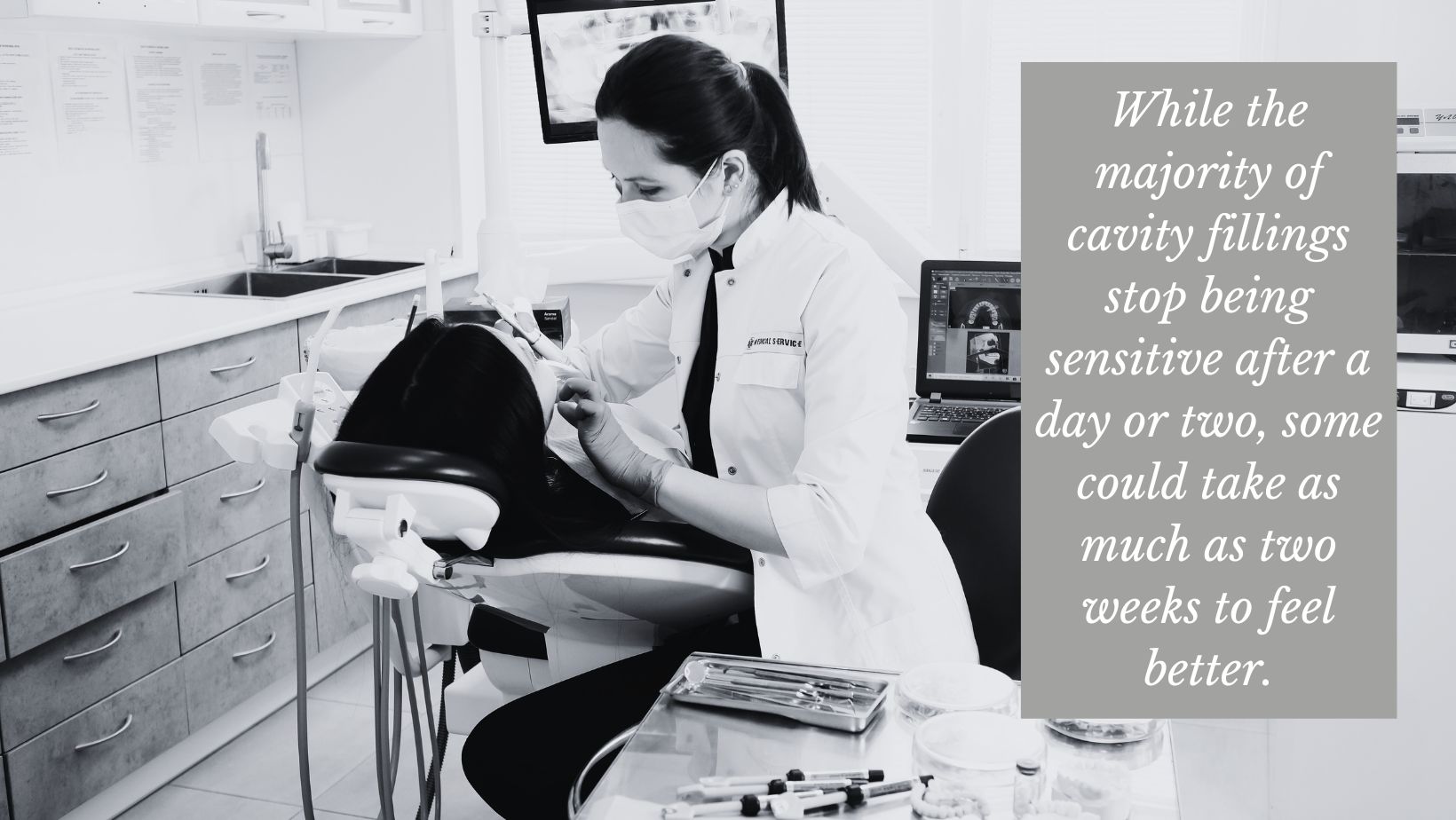In almost all cases, a dental filling is the best solution for a cavity caused by tooth decay. Once the procedure is done, patients are often surprised to still have some sensitivity. This is normal, and most sensitivity is gone within a day or two, or up to two weeks for deeper fillings. If sensitivity is extreme or lasts too long, it could mean there is a problem that requires a call to the dentist.
Is it Normal for a Filling to Be Sensitive?
It is normal for a filling to be sensitive for a short period of time after the procedure. This usually lasts no more than a few hours and often has more to do with the anesthetic wearing off than the filling itself.
Dentists often use a numbing agent called novocaine, which is a local anesthetic, so they can remove a cavity and place a filling without the patient feeling any pain. The patient will not be able to feel the dentist using a drill or other dental instruments being used to fix the tooth.
After the numbness from novocaine wears off, a newly filled tooth can feel sensitive to heat, cold, or biting down. In most cases, patients are back to normal by the next day, able to eat and drink what they please without noticing any sensitivity or pain.
How Long Does Tooth Sensitivity Last After a Filling?
While the majority of cavity fillings stop being sensitive after a day or two, some could take as much as two weeks to feel better. Even then, it may not be a cause for concern. If a cavity was deep or in a location used for heavy chewing, it might take longer to heal. Sensitivity during the healing process is expected.
What to Do If a Filling is Sensitive
How long tooth sensitivity lasts after a filling is different for everyone. If not much time has passed since the procedure, or if sensitivity remains mild, there are a few things a patient can try before contacting the dentist.
- Try over-the-counter pain relievers such as acetaminophen or ibuprofen
- Use toothpaste labeled for sensitive teeth
- Brush and floss gently
- Try topical oral painkillers such as Oragel or Anbesol
- Avoid eating and drinking hot, cold, acidic, or sweet things
- Do not bite down on ice or hard or chewy foods like nuts or toffee
- Avoid teeth whitening products, which can increase sensitivity
If these remedies do not help with a tooth’s sensitivity or pain within a few days or weeks, contact the dentist. They will be able to assess the reason for the discomfort and come up with a solution.

Why Do Fillings Cause Tooth Sensitivity?
There are a number of reasons why filling teeth causes sensitivity. Some are normal reactions to the process itself. These result in sensitivity that goes away quickly.
Sometimes, however, the discomfort could mean that the procedure was not successful or that there is an underlying issue besides the cavity. In these cases, the dentist may need to replace the filling or perform additional dental work to fix the problem.
Deep or Large Fillings
The act of drilling can itself make a tooth sensitive. A deep cavity means the dentist might need to drill close to the root. The heat and vibration from the dental drill can inflame and irritate the nerves and blood vessels at the core of the tooth. Just as a deep cavity might be more sensitive than a shallow one, so will a filling that covers a large portion of the tooth’s surface. In most cases, the sensitivity associated with deep or large fillings will go away once the tooth root heals.
Bad Bite Alignment
As part of the dental filling procedure, dentists typically do a bite test. This ensures that they have shaped the surface of the filled tooth to match the natural contours of the original tooth. If the shape of the filling is off by even a tiny amount, it can interfere with the way the top and bottom teeth fit together. This will add to the sensitivity of the tooth. The dentist can easily fix this by filing and polishing the filling until it is in the correct shape.
Pulpitis
A cavity is the result of bacteria building up on the tooth and eating away the enamel. Left untreated, it will eventually cause a painful infection called pulpitis. If the dentist fails to remove all of the infected tissue, pulpitis can be left behind, trapped inside the tooth by the filling. This condition can quickly go from sensitivity to pain. It’s important to have pulpitis evaluated and treated by the dentist.
Allergic Reaction
Ongoing or severe sensitivity, especially when accompanied by a rash or itching, can mean the patient is having an allergic reaction to the materials used in the filling. If this is the case, the dentist can replace the filling with a different material.
When to Seek Help for Tooth Sensitivity
Though some sensitivity after a filling is normal, there are some things that patients should watch for. These symptoms could indicate that there is a problem:
- Extreme sensitivity that makes it hard to eat or drink
- Sharp or throbbing pain similar to a toothache
- Sensitivity or pain that gets worse over time
- Redness, irritation, or a rash on the surrounding tissue
- A feeling like the teeth do not fit together properly
It is best to contact the dentist right away when experiencing any of these things beyond the first few days. They will either offer some remedies you can try or have you come in so they can check to see if anything is wrong with the filling. Dental fillings are meant to fix cavity pain. There is no reason a patient should feel they need to just “tough it out” if they are feeling discomfort.
Reach Out to a Professional
If you think you have a cavity, do not hesitate to get it fixed. Tooth decay will not go away on its own. Left untreated it can cause much more pain and increase the danger of losing the tooth. If you need to find a dentist, you can start the process of finding a dental professional near you with our make an appointment tool.
This piece was originally published on March 1, 2021.


